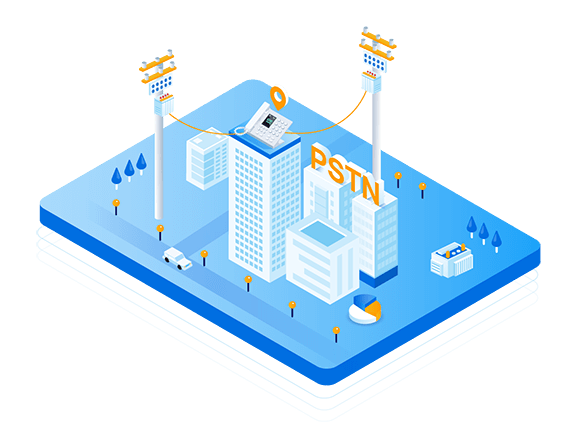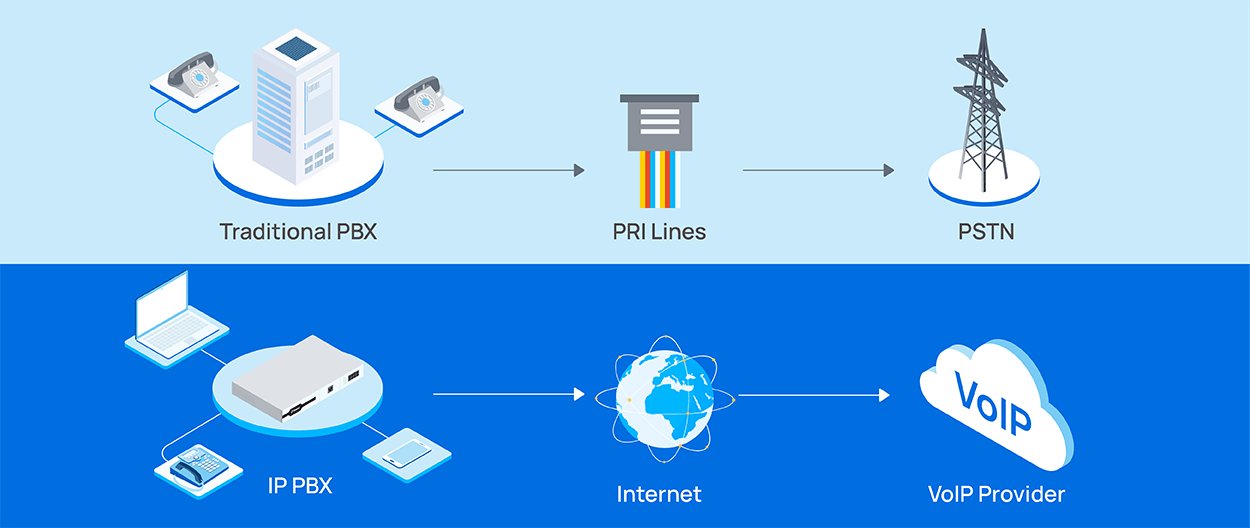A Guide to PSTN: What It Is and & How It Works | Yeastar
 PSTN, Public Switched Telephone Network, is a system that transfers communication through telephone lines. Since the 1800s, people no longer needed to send letters across the globe but could easily connect through fixed-line telephones. PSTN changed the way we communicate and transmit data both personally and in business.
PSTN, Public Switched Telephone Network, is a system that transfers communication through telephone lines. Since the 1800s, people no longer needed to send letters across the globe but could easily connect through fixed-line telephones. PSTN changed the way we communicate and transmit data both personally and in business.
Here, you will learn how PSTN evolved, its pros and cons, and what alternatives are available for modernization.
What Is a Plain Old Telephone Service?
Plain Old Telephone Service (POTS) is closely related to PSTN, a landline phone system; PSTN stands for Public Switched Telephone Network. The underground copper wires have connected homes and companies and allow people to communicate with each other.The only difference between POTS and PSTN is that the latter can use other materials (e.g., fiber), and the former is the traditional “plain” telephone network for voice calls.
By dialing a number on your smartphone or a traditional phone, the telephone networks connect you to the receiver located nearby or overseas; and the tones you hear are actually electrical signals sent through copper wires.
A Plain Old Telephone Service has circuits that must be open when the call is being made; this is because the signals try to reach the other end of the circuit and continue so until the person you are calling is reached. This is why the further you call, the longer time it takes for the signals to arrive; the far-distance calls are also more expensive because the circuits must be open longer.
If you call a company, be it a call center, insurance, or home service provider, more often than not, they will have a PBX that stands for Private Branch Exchange.
A PBX box is a switch that directs your incoming call to any available phone at the company. This way, the business owns one phone number (with extensions) with numerous lines. The same switch is used when an employee makes an outbound call from the company.
History of Public Switched Telephone Network
The first voice transmission was carried out with one wire that connected two devices. Since there were no sounds, people had to whistle to attract the person’s attention on the other side; later on, the bell was added to inform the receiver of a call.
With the advance of technology, people wanted to have a phone in every household. However, it was not possible to establish so many wires between buildings. This is when the control center appears. Whenever somebody was calling, the call would first reach a centralized office, and then the operator would connect the wires in the switch and pass the call to its destination.
Those switches run by operators have been later replaced to analog and then digital switches. Voice signals changed to digital voice signals making the voice quality clearer even at a long distance. PSTN had new features like forwarding and holding a call and joining the conference calls.
How Does PSTN Line Work?
The Public Switched Telephone Network, PSTN, needs a number of things to work: switching centers, satellite and fiber optic cables, cables systems, cellular networks, and telephone lines. As soon as the call is picked up, your voice data is transmitted as digital signals via cables through the network to the recipient’s destination.
Advantages of PSTN
Reliability
Public Switched Telephone Network is a long-used technology that has been developed all around the world. PSTN doesn’t depend on the Internet connection, which means even if you have frequent network crash or power outages, your company can continue answering and making calls.
Security
PSTN network is almost impossible to hack into since it has dedicated underground copper wires. Thus, telephone communication is very secure and reliable for businesses and individuals.
Usability
The PSTN system is very easy to use at work, especially for people who are not familiar with new technologies. You will have basic features of forwarding and muting a call, leaving a voicemail, and putting it on hold, and these options aren’t hard to learn.
Disadvantages of PSTN
Price
The price for personal use is not high since you only purchase a subscription for your traditional phone.The costs of PSTN systems for businesses are much higher because every employee requires an individual line. Installing lines and paying for phone bills can be financially demanding for a small business.
Additionally, you will need to purchase a PBX (Public Branch Exchange); it will keep all the company numbers in one place and route external calls internally. It is easy to use but costly to install and maintain; you will need a separate room to keep it and an IT professional to troubleshoot any issues.
Limited Phone Calls
Your business will have to pay for calls, or there can be an option of purchasing a package with minutes. In any case, if you need to make calls abroad, it can be quite costly.
Lack of Advanced Features
For some companies, the basic features are enough; however, they are not sufficient for others. As the modern workforce becoming more agile, unified communications is going to be the next of norm, which PSTN cannot support. It also falls short in terms of equipping remote working employees to stay connected with colleagues and customers.
Alternatives of PSTN for Businesses
Some companies find PSTN as outdated and limited, and they prefer to switch to more modern alternatives-VoIP.
ISDN vs. PSTN
Before VoIP, ISDN used to be an alternative for PSTN.ISDN stands for Integrated Services Digital Network, which also utilizes circuit switching technology and transmits both voice and data over the same wire, while PSTN can only transfer voice. The other advantage of ISDN is that it has better voice quality and faster exchange compared to the Plain Old Telephone Service.
ISDN was developed after PSTN in 1991 and was used by the public a year later. It is popular among large businesses because of its speed and quality. Apart from those benefits, ISDN can have two connections (phone, video, fax, data) simultaneously.
However, with telecommunications providers shutting down the service globally, the era of ISDN has come to an end.
Infographic isdn-switch-off-what-the-future-holds-for-your-business
VoIP vs. PSTN
VoIP is Voice over Internet Protocol , also known as IP telephony which allows you to make calls over the Internet. Unlike ISDN and PSTN, Voice over IP doesn’t use a circuit switching phone system and only utilizes the Internet connection, making it an ideal alternative for small companies.
PSTN sends a voice signal over the wire, and VoIP converts audio into data packets and then back to audio when it reaches the recipient.
Compared to PSTN, Voice over Internet Protocol(VoIP) has multiple features to fulfill more sophisticated business needs. Besides speaking and using basic features like muting, forwarding, and holding the call, VoIP lets employees send instant messages, leave voicemails, attend video conferencing, among many other things.
Another big difference is portability. PSTN phone lines can only be connected physically in the office, and VoIP can be used from anywhere in the world as long as there is a reliable Internet connection.Employees can take their own devices, either mobile phones or computers, as office extensions and take business calls from anywhere.
When it comes to costs, the price of VoIP installation is much lower than PSTN since there is no need to purchase physical lines and proprietary phones. Start-ups prefer to work with VoIP since it allows them to bring employees everywhere together and because Internet telephony offers all the useful key metrics.

Switch to VoIP to Improve Business Efficiency
Public Switched Telephone Network is a traditional landline that has been used for years by businesses and individuals. While PSTN ushers modern communications, as technology evolving and the becoming matured and stabilized, VoIP has gradually become the best choice for communication systems.
Based on VoIP, Yeastar PBX Systems are designed to provide a full suite of unified communications solution for small and medium-sized businesses. Yeastar offers features from must-have to nice-to-have for enterprise-class communications, such as UC Clients,Call Center, CRM integration, Video Conferencing, Instant Messaging, Softphone, etc.
If you are looking for a versatile unified communications system that suppots onsite, remote, and mobile workforce. Yeastar could be your go-to option. Sign up for 30-day free trial to experience for yourself.
















![Toni Kroos là ai? [ sự thật về tiểu sử đầy đủ Toni Kroos ]](https://evbn.org/wp-content/uploads/New-Project-6635-1671934592.jpg)


